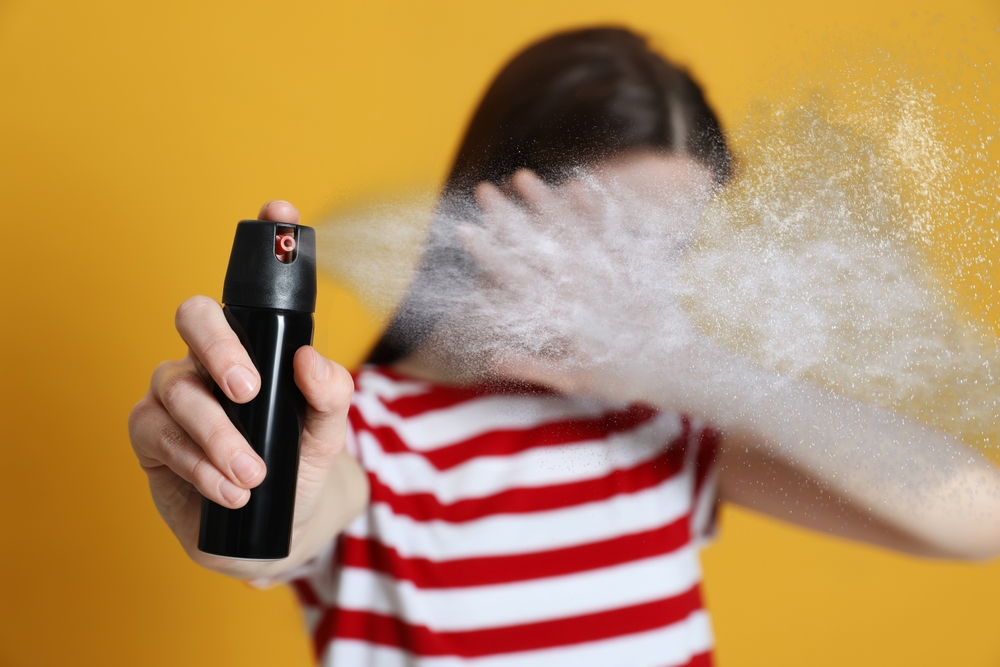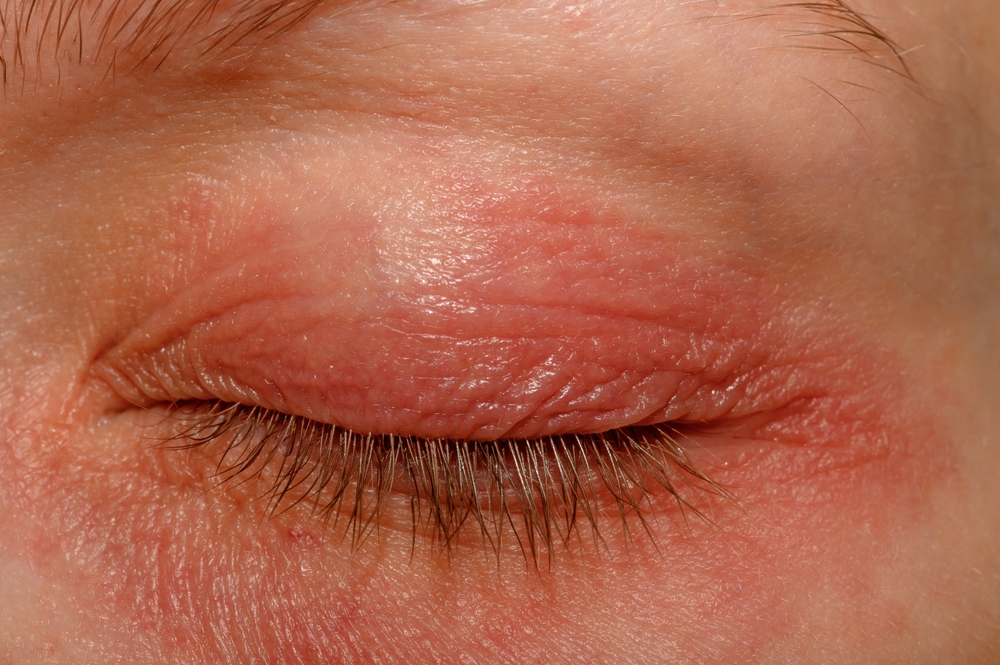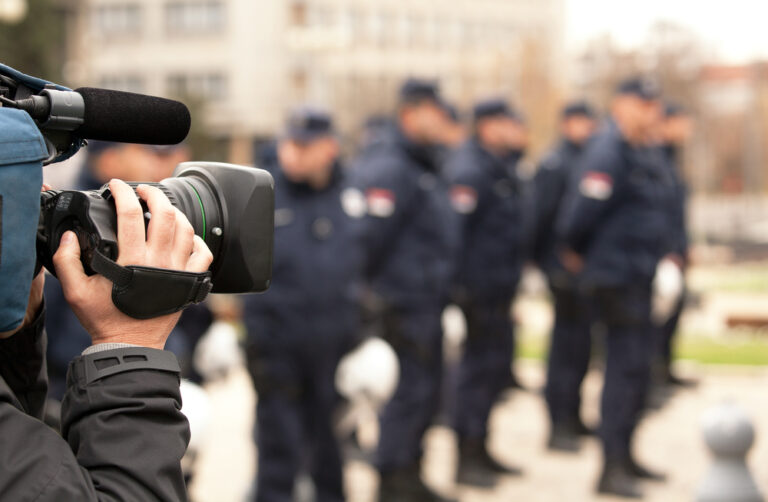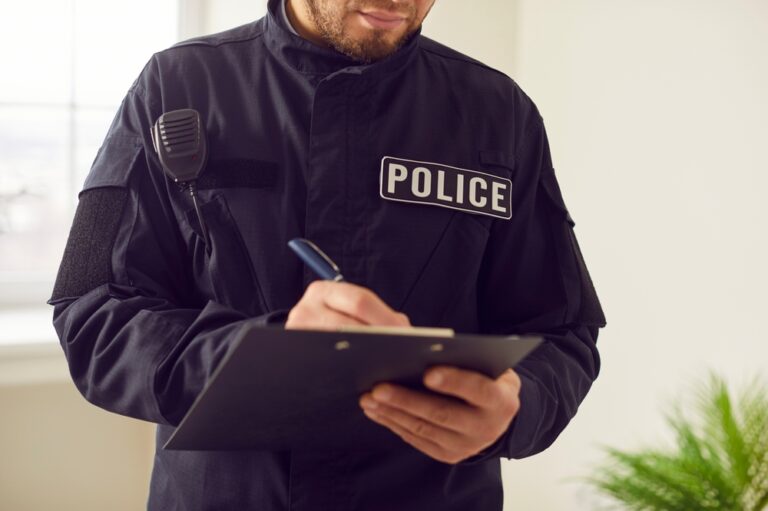
Police Tape 101: Everything You Need to Know
Police tape, commonly known as crime scene tape, is an important tool used by law enforcement to secure…

Pepper spray gets its name from capsaicin, the ingredient that gives chili peppers their hot flavor.
If you have chopped peppers and mistakenly rubbed your eyes, you’ve experienced a fraction of how pepper spray affects our senses.
As you can imagine, exposure to pepper spray is one of the most unpleasant experiences anyone can experience.
Because it has an instantaneous effect, knowing how to get pepper spray out of eyes is essential.
To help you learn more about it, we’ll explore relevant subjects surrounding pepper spray and how to minimize its effects.
Before we talk about how to get pepper spray out of eyes, let’s check out what’s inside of this non-lethal irritant.
The active ingredients in pepper spray are known as capsaicinoids, officially referred to as oleoresin capsicum (OC).
Capsaicin is the most significant ingredient in pepper spray, which is a component of OC that gives chilies their heat.
It is created using a process that liquefies and condenses chili peppers into a solution.
That said, pepper sprays have a more potent and weaponized form of capsaicin compared to the solution used in condiments.
Capsicum oil is also one of the core components of bear spray, an aerosol meant to safeguard humans who come into contact with large wild animals.
That said, not all capsaicinoids are extracted from jalapeno pepper or other similar fruits.
For instance, nonivamide is usually an artificially-made, strong irritant utilized in commercial pepper sprays.
These inconsistencies in the effects are due to the components inside the canisters.
While capsicum is universally used, there are several ingredients in the sprays used by manufacturers today.
You may encounter a brand that combines the OC solution with water or solvents such as ethyl alcohol.
Others might have their spray propellants comprised of carbon dioxide and nitrogen.
Interestingly, precise details regarding the OC concentration or the complete ingredients on the label are not always available.
That’s why it is challenging for scientists to evaluate pepper spray in general and uncover specific effects besides its initial consequences.
With minimal regulation and no dedicated research that analyzes unique compositions, it is difficult to solidify universal guidelines that ensure public safety.
In 2019, the United Nations established universal standards for the use of non-lethal weapons in police enforcement.
It includes crowd control tools like pepper spray, tear gas, rubber bullets, and batons.
However, the enforcement appears to be lacking, and no agencies have taken serious action to address these concerns.
Pepper spray is a bit of an enigma in regards to its effects on our bodies.
Some may experience a quick recovery, but others could have their eyes and skin irritated or worse for days.
Depending on the effect, it will almost likely keep you from performing your anti-riot tasks.
Aside from skin irritations, here are other possible effects of pepper spray exposure:
If you have any pre-existing cardiovascular or respiratory issues, it may cause more severe responses with dreadful consequences.
People with asthma directly exposed to pepper spray need emergency services because it may trigger a life-threatening asthma attack.
However, if you don’t suffer from the same serious respiratory issues, you may follow the steps below to remove pepper spray below.
Capsaicin is safer than the initial iterations of tear gas that could lead to broad keratopathy.
According to some research, a single exposure to capsaicin causes ocular surface injury, but the conjunctiva and cornea are mostly unharmed.
In extreme cases, you may feel chronic discomfort, photophobia, a burning sensation, exudate or discharge, and other symptoms.

OC was developed as an aerosol spray in 1973 and was used by the FBI to incapacitate animals and people temporarily.
The FBI was the first to use the item in their operations, followed by the NYPD in 1991.
Today, around 97 percent of law enforcement personnel, including local police officers, use pepper spray.
It is categorized as a non-lethal weapon to disperse unruly protestors, mobs, and other hostile groups of people.
There are a variety of situations where you can make contact with pepper spray, deliberately or inadvertently.
For example, law enforcement officers often use pepper spray to neutralize civilian protesters, which may require medical attention if left untreated.
The Scoville heat units (SHU) scale, which measures the heat, gives pepper spray a significantly higher rating than the spiciest chili sauces.
As such, you will want to learn how to get it out of the eyes if you accidentally sprayed it on yourself or anyone else.
Getting pepper-sprayed can cause severe irritation, leading to a great deal of pain.
Since it is designed as a chemical irritant, removing it from the eyes and skin won’t be easy.
After a pepper spray exposure, avoid touching your eyes or face until there’s no pepper spray residue left.
You will distribute the solution more and exacerbate the problem if you carelessly rub or touch your face.
Instead of doing that, make your eyes tear up by blinking while not touching any area of your face.
Blinking releases tears that work as a natural saline solution.
That said, while it is a good first step to removing the pepper spray from your eyes, it won’t be enough.
For those wearing contact lenses and got pepper sprayed, don’t remove them immediately.
Submerge your eyes in cold water and blink as many times as possible. Then, once the pain is more tolerable, remove the contact lenses.
Note that the residue will cling to the lenses deeply and essentially make them unusable even if you do a thorough cleaning.
You won’t be able to get rid of the intense pain or irritation immediately. As such, you might find that this step is the most gruesome because it is all about repetition.
For 10 to 15 minutes, keep flushing your eyes with fresh, clean water.
After a couple of flushes, you need to let your eyes be exposed to air to help the irritant evaporate faster.
Keep at it until there is a substantial improvement in your condition.
Make sure you use dry towels to wipe out excess water but avoid rubbing them to minimize the spread.
If you have eye drops, use them to help your eyes have a constant saline supply.
Once your eyes become less irritated, it’s time to work on other areas.
Grab a clean, dry towel and dip it in a soap solution. Use the soapy towel to clean your face, neck, and other body parts that got in contact with pepper spray.
If your inner nose is affected, try to make a homemade saline solution to alleviate the irritation.
You can prepare it by mixing two cups of warm water with a teaspoon of salt. Then, gently apply the solution to your inner nose using a thin, clean cloth.
After that, produce and cleanse everything with soapy water. Avoid your eyes from contact with the soap because it may cause additional irritation.
There is a high chance your clothing has some pepper spray residue.
To prevent your clean eyes and skin from further contact, change into clean clothes.
If possible, put the contaminated clothes in the laundry as soon as possible. Remove your accessories while at it because they may also contain residuals.
Riot control agents such as pepper spray can cause a variety of harmful effects on our bodies, especially the eyes.
Immediate exposure to tear gas or pepper spray will induce excessive tearing, blurred vision, burning, and swelling.
Long-term conditions such as glaucoma or blindness are also possible, making pepper spray exposure a dangerous experience.
As such, law enforcers should know the importance of how to protect the eyes to ensure they are able to perform crowd control duties effectively.
Here are some important safety tips to keep in mind:
Officers have access to protective gear, especially if they are a part of the anti-riot unit.
These items can help protect against injuries and irritation from pepper spray, rubber bullets, and smoke.
While they won’t completely shield you, wearing eye protection gear is preferable to nothing.
Even better, the majority of these items are widely accessible and inexpensive.
You can get sprayed by hostile protesters at any time. And, sometimes, protective gear isn’t enough to keep your eyes shielded from harm.
This is why we recommend bringing some useful items in your patrol bag to prevent inconvenience or additional injuries.
Contact lenses can trap tiny, toxic particles from pepper sprays and tear gas in your eyes, which makes the adverse effects worse than it usually is.
They also clog the tear ducts, hampering the ability of the eyes to self-clean.
On top of that, your uniform and protective gear will make you sweaty. When this happens, your eyes will become more prone to itchiness and irritation.
Getting pepper-sprayed is an excruciating experience that requires immediate attention and care.
Always be ready to take action once your eyes and skin are exposed.
Wear protective gear and keep essential items with you, especially if you are expecting protesters and other groups to be hostile.
By being knowledgeable and prepared, you are potentially minimizing the effects of pepper spray on your eyes and skin.

Police tape, commonly known as crime scene tape, is an important tool used by law enforcement to secure…

The police are called daily regarding various incidents of public interest. It is our responsibility to provide the…

Many police officers experience terrible, traumatic events in the line of duty. A significant number of police officers…